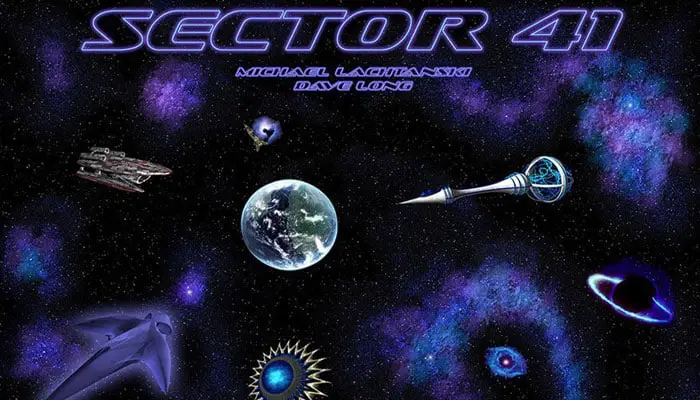
Components

- 85 Tiles
- 12 Explorers
- 21 Glynium discs
- 1 Guardian
- 4 Rule Sheets
- 1 Variant Sheet
- Instructions
Object of the Game
Players collect Glynium by towing it onto their Mother Ship with an Explorer. The Glynium collected is scored as follows: Yellow - 1 Point, Blue - 2 Points, Red - 3 Points.
Whoever has the most points at the end of the game is the winner. The game ends when no other player can surpass the score of the current leader. Collected Glynium should always be kept in plain sight so that all players can know the current score.
If two or more players are tied for the most points after all the Glynium is collected then the tied player who first reached that score is declared the winner.
Setup
Set aside the 4 Mother Ship tiles pictured below:

Place the remaining 81 tiles face down and mix them up to form a 9 x 9 grid on the table. Place the Glynium off to the side.

Reveal the center tile of the grid and place the Guardian on it. Choose a starting player.
Each player selects a Mother Ship and places it along an unoccupied edge of the grid in the same column as the Guardian. In a 2 player game the players must be on opposite edges of the grid. All players place the 3 Explorers of their color on top of their Mother Ship.

Game Play
Beginning with the starting player and continuing clockwise around the table each player's turn consists of 3 phases done in order:
1. Mother Ship Phase
Choose one of the following options: Move your Mother Ship, Fold Space, or Do Nothing.
Moving your Mother Ship: Move your Mother Ship (including any Explorers on top of it) up to 2 spaces to the left or right. You may not leave your side of the grid but wrapping directly between the left-most and right-most columns is permitted.
Keep your Mother Ship across from your opponent's Mother Ship so you are always ready to fight for any Glynium that is discovered.
Folding Space
Spread the tiles apart a little bit to clear the column in front of your Mother Ship. Push your Mother Ship into the grid sliding the column of tiles away from you and pushing the far tile out of the opposite side of the grid.

Then slide your Mother Ship back out to the edge where it started and move the displaced tile to the empty space in front of your Mother Ship, maintaining the tile's original orientation. Then tighten up the grid by sliding the tiles back together. (See the diagram above)
Folding Space does not reveal unexplored tiles and does not allow tiles to be rotated.
A Mother Ship always finishes a Fold Space move exactly where it started and all objects on top of the tiles move along with the tiles. Players opposite each other on the grid may not "un-fold" space by folding the same column that the opposing player folded on his or her previous turn.
Manipulate the grid and play on your terms. Don't let the luck of the initial tile placement dictate your fate!
Proactively Fold Space and move a close tile with Glynium further away from you to prevent your opponent from folding it over to his side of the grid.
2. Explorer Phase
Select one (and only one) Explorer and move it one tile in any direction: horizontally, vertically, or diagonally. When entering or leaving their Mother Ship, Explorers may NOT move diagonally in or out.
However, when following tile instructions Explorers are allowed to enter their Mother Ship diagonally. When an Explorer moves onto an unexplored (face down) tile that tile is explored and turned face up.
The current player may not look at the tile to determine orientation as it is revealed. When an Explorer moves onto a tile it must immediately follow the rules for that tile.
Explorer Movement Details:
-
You must move one Explorer each turn, if possible, and you may NOT "stay put" on your current tile as your move.
-
Whenever a tile instructs an Explorer to jump to another tile, intervening tiles are skipped and not explored or interacted with.
-
When following tile instructions for purposes of Explorer movement your Mother Ship is considered to be a part of the grid and is treated like any other already explored (face up) tile. Explorers on their Mother Ship are considered in play. You may never move onto an opponent's Mother Ship.
-
Explorers are bound by the edges of the grid and if a tile directs an Explorer to make a move which would cause it to leave the grid then the Explorer does not move and the phase is over.
If a tile offers a choice of moves to the Explorer, any options that cause the Explorer to leave the grid may NOT be chosen.
-
If at any time all of your remaining Explorers are unable to move then immediately remove all of your Explorers from play.
-
At the start of your Explorer Phase if you have no Explorers left in play then put an Explorer into play on your Mother Ship and move as normal.
-
Random tile placement may cause an "infinite loop" to be created where an Explorer cannot ever leave. In this case the Explorer is destroyed and removed from play. Any Glynium being towed is left behind on one of the tiles in the loop chosen by the owner of the destroyed Explorer.
Towing Glynium: When moving an Explorer onto a previously explored tile if the tile you are leaving has one or more Glynium discs on it you may choose to tow a single Glynium disc along with your Explorer.
Unless tile instructions indicate otherwise, you may always choose to tow Glynium when moving your Explorer onto a previously explored tile or your own Mother Ship; however, due to its volatility, you may never tow Glynium onto unexplored (face down) tiles.
Combat: Combat occurs whenever an Explorer enters a tile occupied by one or more enemy Explorers resulting in all of the enemy Explorers being returned to their Mother Ship, unless the tile is an Asteroid Belt tile, in which case all of the enemy Explorers are removed from play instead.
Shielding: When a player has a continuous movement path from their Mother Ship to a tile containing a single one of their own Explorers then that Explorer is considered shielded by the Mother Ship and immune to combat.
Explorers may never enter a tile containing a shielded enemy Explorer. Mother Ships can shield multiple tiles with individual Explorers but provide no shielding to any tile containing more than one Explorer.
3. Guardian Phase
The Guardian, a native of Sector 41, is immune to all tile effects and is bound by the edges of the grid. The Guardian does not affect Explorers or Glynium prior to Awakening. The Guardian starts the game in Wandering mode and is moved by the current player as follows:
-
The Wandering
In this mode the Guardian is moved only if an Explorer was moved onto an unexplored tile during the Explorer phase. The Guardian is moved one tile in any direction and explores (turns face up) any unexplored tile it is moved onto. Glynium Planets receive Glynium discs as usual.
-
The Quickening
As the red Glynium disc enters play the Quickening begins and the Guardian is now moved every turn.
In this mode the Guardian is moved one tile toward the closest unexplored tile (current player's choice if more than one option) and explores any unexplored tile it is moved onto.
-
The Awakening
When all tiles are explored move the Guardian to the center tile (don't cleanse it) then begin the Awakening! In this mode the Guardian is moved one tile toward the closest un-cleansed tile (current player's choice if more than one option).
The Guardian cleanses any tile it moves onto by turning it face down and removing from the game any Glynium or Explorers on it. Explorers may not enter cleansed tiles and columns containing such tiles may not be folded.
You don't always have to satisfy the conditions of tiles that slow you down, consider using a Star Gate or Starbase to free your Explorer at a later time.
A Mother Ship Beacon can be used to quickly bring Glynium home to your Mother Ship.
You can safely reveal the sector without risking your Explorers by using the Spacial Distortions and Remote Viewports.
Tiles

Alien Artifact (x3) - This strange alien power source warps space and your Explorer is hurled away!

Always heading away from the artifact select one tile, horizontally or vertically, followed by one tile diagonally, and jump to that second tile. For further movement purposes your Explorer is considered to be moving along the chosen diagonal.

Asteroid Belt (Asteroid-2 x4, Asteroid-3 x2) - Place your Explorer on asteroid 1 and end the phase. This tile is one of six access points to the sector's Asteroid Belt.
If an Explorer began the phase on this tile's highest numbered asteroid then it may choose to leave, otherwise it may not leave and may only move onto the next higher numbered asteroid on this, or any other, Asteroid Belt tile.

Barren Planet (x2) - A faulty sensor reading causes your Explorer to waste time looking for Glynium where there is none and the phase ends. Your Explorer may not move on your next turn and it should be laid down on its side to indicate so.
Stand it up at the end of the Explorer Phase of your next turn or if it is returned to your Mother Ship.
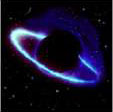
Black Hole (x2) - Your Explorer crosses the event horizon and is sucked in to the gravity well of a Black Hole! Remove your Explorer from play and end the phase.
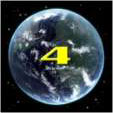
Glynium Planet (Glynium-2 x4, Glynium-3 x3, Glynium4 x1) - This planet contains Glynium deposits! The number designates how many Glynium discs to place on this tile when this tile is first turned over.
Place all 18 yellow discs from the supply first, then the 2 blue discs, and finally the red disc (see rule 3b). Moving onto this tile ends the phase.

Ion Storm (x2) - Exchange this tile with any other explored tile in the grid maintaining orientation. Objects on top of the tiles do NOT move with the tiles. Explorers that have tiles placed under them are not affected in any way.
Such Explorers are placed so they may move away freely on a future turn (outside a nebula, on the highest Asteroid #, etc..). The phase is over. Cleansed tiles are not considered explored tiles and may not be exchanged.

Mother Ship Beacon (x2) - This beacon forms a sub-space conduit that leads directly back to your Mother Ship. Your Explorer jumps directly to your Mother Ship and the phase ends.
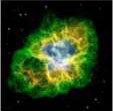
Nebula (x2) - Your Explorer gets lost in a nebula and the phase is over. Place your Explorer inside the nebula to indicate it is trapped and cannot leave unless another of your Explorers is on this tile as well.
Once two or more of your Explorers are here then none are trapped and all may leave (place them on the edge of the tile outside the nebula to indicate they are free).
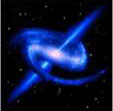
Pulsar (x4) - The energy of the pulsar jumps your Explorer to the second tile in the direction of either of the blasts (upper right and lower left in the picture shown here) - your choice.

If you are unable to jump to either of those two tiles then end the phase on this tile.
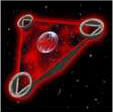
Remote Viewport (x2) - In a failed attempt to safely navigate this sector, ancient travelers built viewports to safely scan remote locations.
You may use this viewport to look at an unexplored tile of your choice without revealing it to other players or re-orienting it. The phase is over.
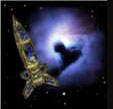
Salvage Explorer (x3) - One of the many Explorer Ships lost in this Sector ages ago emerges from a tear in the fabric of space and with a few upgrades it will be good as new!
If any of your Explorers have been removed from play return one into play on your Mother Ship. The phase is over.

Solar Flare (x2) - A solar flare slams into your Explorer! Jump in the direction of the flare (upper right in the picture shown here) to the next unexplored tile.
If none, jump to the edge of the grid in the indicated direction. If you can't move at all end the phase on this tile.

Solar Tempest (x2) - This violent solar activity blasts your Explorer to the edge of the sector! Jump to the edge of the grid in the direction of the tempest (upper left in the picture shown here).
If you are already at the edge of the grid then end the phase on this tile.

Solar Wind (various Configurations, 16 Total) - Your Explorer is pushed away by the solar wind here.

Move your Explorer one tile in any of the directions indicated by the arrow(s), your choice. If you can't move in any of the indicated directions then end the phase on this tile.

Space Rift (x4) - You discover an eddy in the fabric of space. If possible, move your Explorer one additional tile in the same direction you were heading. If not, then end the phase on this tile.

Spacial Distortion (x6) - You peer through a rift in space to a different part of the sector. Turn over the closest unexplored tile (your choice if more than one option).
Your Explorer remains here and the phase ends. Cleansed tiles are not considered unexplored tiles and may not be turned over.

Starbase (x3) - You may use the weapons of the Starbase to send one other Explorer within a two tile radius of this Starbase back to its Mother Ship as long as that Explorer is not shielded.
The other Explorer may belong to any player, including you. (Glynium is not moved along with the other Explorer). The phase is over.

Star Gate (x3) - This ancient stellar phenomenon allows you to immediately summon any other Explorer that you have in play.
You may move one of your other Explorers to this tile. (Glynium is not moved along with the other Explorer). The phase is over.

Super Nova (x3) - Your Explorer is able to harness the massive energy of this Super Nova!

Jump in a straight line to the second tile in any direction including diagonals - your choice.

Temporal Anomaly (x2) - The space/time continuum is shattered and your Explorer travels back in time!
Jump back two tiles in a straight line in the direction from which you came. If you are unable to jump back two tiles then only move back one tile.

Vortex (x2) - This maelstrom grants you the power to alter the fabric of space itself.
Change the orientation of any one tile in the grid and end the phase. If you choose to rotate an unexplored tile you must do so without revealing it.

Worm Hole (x2) - Move your Explorer through hyperspace to a Star Gate of your choice.
If no Star Gates are currently exposed then end the phase on this tile.
Continue Reading
